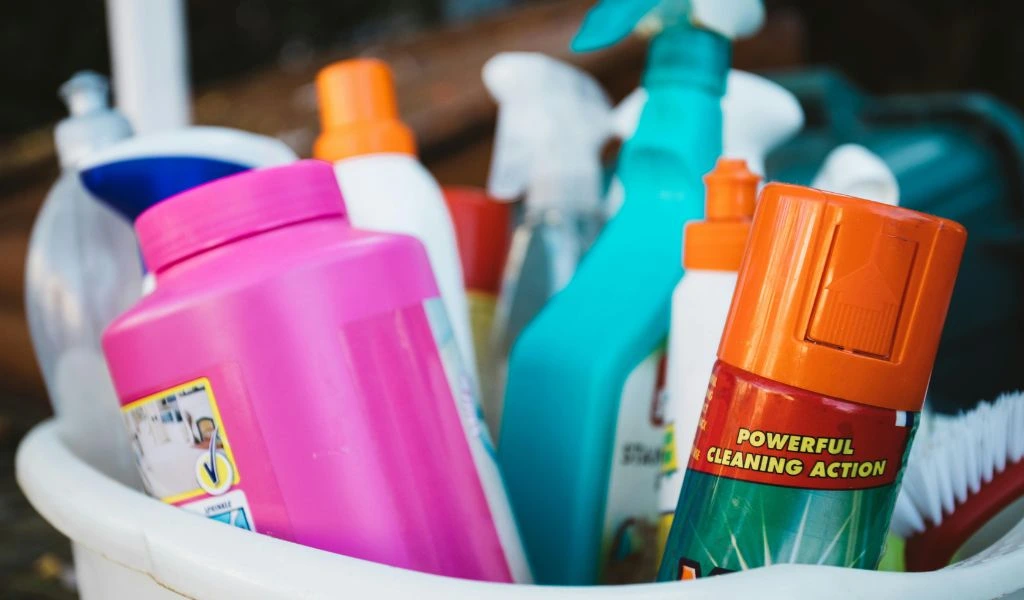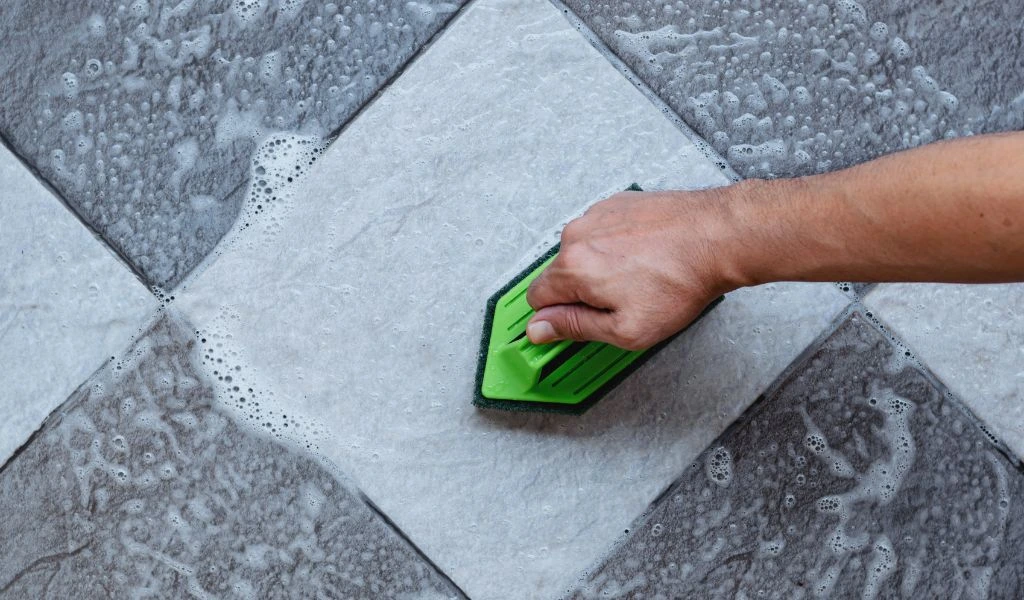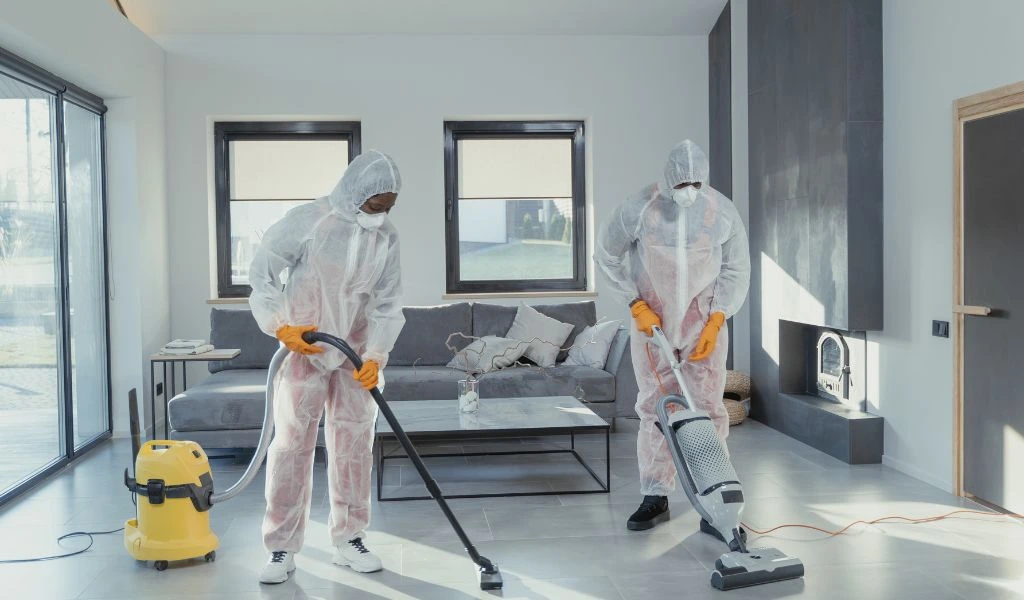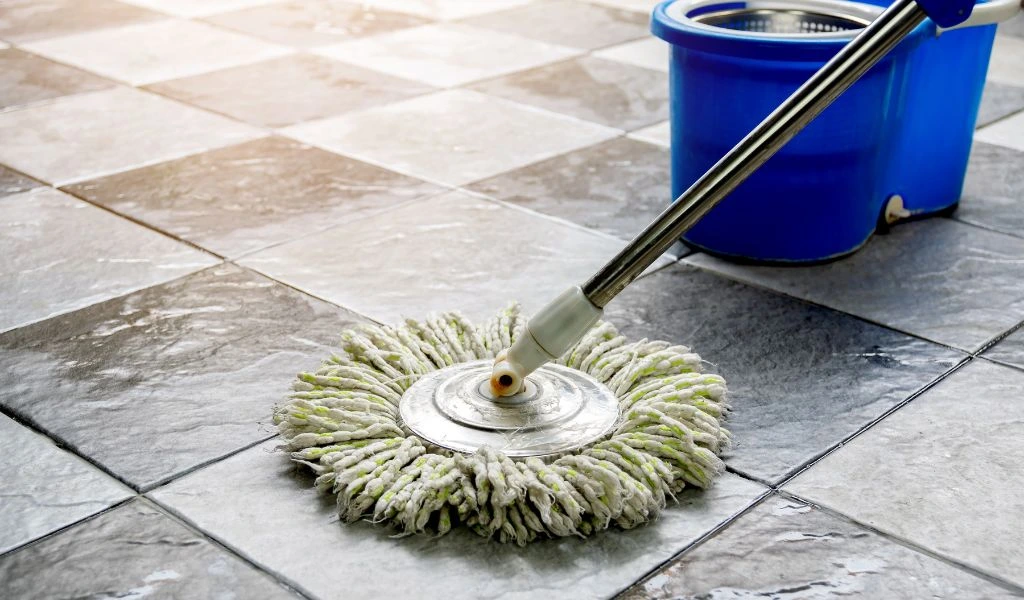Tiled floors are easy to love. They’re stylish, practical, and built to last.
But when it comes to cleaning them, that’s where things often go wrong.
Different types of tiles need different care. What works on ceramic might damage natural stone. Too much water on vinyl can cause lifting. And using the wrong cleaner can leave behind streaks, stains, or even permanent damage.
In this guide, you’ll learn the best way to clean floor tiles, based on the material. From porcelain and stone to vinyl and terracotta, we’ll walk you through the exact steps
Know Your Tile Type
Before you start cleaning, it’s important to know what type of floor tile you have.
Why?
Because using the wrong cleaner can damage your tiles, leave streaks, or even wear down the surface over time.
Here’s a quick guide to the most common types of floor tiles and how to spot them:
| Tile Type |
How to Identify |
Where You’ll Often Find it |
| Ceramic |
Smooth, often shiny, with printed patterns. Feels light and glazed. |
Kitchens, bathrooms, laundry |
| Porcelain |
Very smooth and dense. Looks similar to ceramic but heavier and more refined. |
Bathrooms, outdoor, high-traffic areas |
| Natural Stone |
Textured, uneven, often has natural veins or speckles. Cool to touch. |
Entryways, living areas, high-end homes |
| Vinyl Tiles |
Soft, flexible, often looks like wood or stone. Slightly cushioned feel. |
Bedrooms, rentals, kitchen floors |
| Terracotta/Quarry |
Matte, earthy red or brown. Slightly rough and porous if unsealed. |
Older homes, patios, rustic spaces |
How to Clean Floor Tiles?
Not all floor tiles are made the same so they shouldn’t be cleaned the same way.
Different tiles have different textures, levels of absorbency, and surface strength which is why it is important to clean them accordingly.
For example:
-
-
- Porous tiles like natural stone or terracotta can absorb water and stain easily.
- Smooth glazed tiles like ceramic and porcelain can handle more moisture and stronger cleaners.
- Vinyl tiles are water-resistant but can be damaged by too much water or harsh chemicals.
That’s why using the right cleaning product and method for your tile type is so important. It helps avoid damage, keeps your floors looking fresh, and extends their lifespan.
| Tile Type |
Recommended Cleaning Solution |
What to Avoid |
| Ceramic |
Warm water + mild detergent or floor cleaner |
Oil-based cleaners, wax, strong acids |
| Porcelain |
Vinegar + warm water (1:4 mix) or a pH-neutral cleaner |
Abrasive tools, wax-based polish |
| Natural Stone |
pH-neutral stone cleaner + warm water |
Vinegar, lemon, bleach, ammonia |
| Vinyl Tiles |
Few drops of dish soap + warm water |
Soaking the floor, steam mops, abrasive pads |
| Terracotta / Quarry |
Specialised tile soap (like Lithofin) + warm water |
Acidic products, too much water if unsealed |
How To Clean Porcelain and Ceramic Floor Tiles

Porcelain and ceramic tiles are some of the most durable flooring options. They’re low-maintenance, but they still need proper care to avoid build-up, stains, and hazy finishes over time.
Best Cleaning Solution: Warm water + a few drops of dish soap (avoid harsh cleaners and steam)
Materials Required:
-
-
- Soft broom or vacuum
- Bucket
- Damp mop or microfibre cloth
- Mild dish soap
- Clean water to rinse
Cleaning Steps:
-
-
- Remove dust and grit first: Start by vacuuming or sweeping the floor to pick up dust, dirt, and loose grit. This helps prevent small particles from scratching the glazed surface when you mop later.
- Use a soft mop with the right cleaner: Mix a few drops of mild detergent into warm water, and mop using a flat or microfibre mop. Avoid sponge mops as they can drag dirty water across the floor and push it into grout lines.
- Check for marks or stains: If you see dark spots or dull patches, figure out what’s caused them. It could be grease, hard water, or soap. Spot-clean using a suitable cleaner, like diluted vinegar (for porcelain only) or a gentle tile cleaner.
- Clear away any film or haze: Sometimes tiles look cloudy after cleaning because of the leftover soap. Mop again using clean water, or wipe the surface with a damp cloth to remove any residue.
- Dry the surface to finish: Once clean, go over the floor with a dry towel or a clean microfibre mop. Drying helps avoid streaks, prevents slipping, and keeps the surface looking polished.
How To Clean Stone Floor Tiles
Stone tiles like marble, slate, or travertine add natural beauty to your space, but they’re more delicate than they look. They’re porous and can be stained or etched easily if you use acidic or harsh cleaners.
Best Cleaning Solution: pH-neutral stone cleaner + warm water (never use vinegar, lemon, or bleach)
Materials Required:
-
-
- Soft broom or vacuum with brush attachment
- Bucket
- Damp mop (not dripping)
- pH-neutral stone cleaner
- Dry towel or soft cloth
Cleaning Steps:
-
-
- Start with a gentle sweep: Use a soft broom or vacuum with a brush head to remove dust, grit, and small debris. Avoid anything abrasive that might scratch the surface.
- Prepare a mild cleaning mix: Add a pH-neutral stone cleaner to warm water (follow product directions). This protects the surface while lifting dirt effectively.
- Use a damp mop (not wet): Mop the floor using a soft mop. The mop should be damp, not soaking. Too much water can seep into unsealed stone and cause damage.
- Rinse lightly if needed: If any cleaner is left behind, wipe the floor with a clean damp cloth. A light wiping is enough so do not use too much water.
- Dry immediately: Use a towel or dry cloth to soak up any remaining moisture. Stone tiles should always be dried to avoid water spots and surface stains.
How To Clean Resilient Floor Tiles

Resilient floors are great for busy households. They’re soft underfoot, water-resistant, and easy to maintain. But too much water or the wrong cleaner can damage the surface over time.
Best Cleaning Solution: Warm water + a few drops of dish soap (avoid soaking and steam mops)
Materials Required:
-
-
- Soft broom or vacuum
- Bucket
- Damp mop or microfibre cloth
- Mild dish soap
- Clean water for rinsing
Cleaning Steps:
-
-
- Remove surface dirt first: Sweep or vacuum to get rid of crumbs, dirt, and dust. Grit can scratch the surface or leave marks when mopping.
- Mix a gentle cleaner: Add a small amount of dish soap to warm water. Keep the solution light to avoid sticky or soapy build-up.
- Use a damp mop, not wet: Mop the floor with minimal water. Resilient floors don’t like excess moisture as it can seep into seams or edges and cause lifting.
- Rinse lightly if needed: If any soap is left on the surface, go over it with a damp mop using just clean water.
- Let the floor air dry: Vinyl and linoleum dry quickly on their own, but you can use a dry mop or towel if needed to speed things up and avoid water spots.
Grout Cleaning Tips
Cleaning grout is a bit different from cleaning the tiles themselves.
Grout is porous and sits lower than the tile surface, which means it absorbs dirt, spills, and moisture much more easily.
Even if your tiles are sparkling, dirty grout lines can make the entire floor look dull or stained.
Unlike tiles, grout needs targeted scrubbing and the right cleaner to remove deep-set grime and restore its color.
How to Clean Grout Between Tiles

-
-
- Make a cleaning paste: Mix baking soda with water to form a thick paste. For ceramic or porcelain tiles, you can also mix baking soda with vinegar but avoid vinegar on natural stone tiles.
- Apply to grout lines: Spread the paste directly over the grout using a brush or your fingers. Let it sit for 5–10 minutes to break down the dirt and stains.
- Scrub the grout: Use a stiff brush or an old toothbrush to scrub the grout lines in a circular motion. Focus on the most stained or discolored areas.
- Wipe clean: Use a damp cloth or sponge to wipe away the paste and dirt. Rinse the cloth and repeat if needed.
- Optional: Use a commercial grout cleaner. For really stubborn stains, you can use a pH-neutral grout cleaner. Always follow the product instructions and test it on a small area first.
- Dry the floor: Wipe the area dry with a clean towel. This helps prevent new dirt from sticking to damp grout.
Common Mistakes to Avoid
Even with the right intentions, small cleaning mistakes can damage your tiles or grout over time.
Here are some common tile-cleaning mistakes to avoid:
-
-
- Using the wrong cleaner can stain or damage your tiles, especially if they’re natural stone.
- Skipping regular sweeping lets dirt build up and scratch the surface over time.
- Cleaning with a sponge mop pushes dirty water into the grout, making it harder to keep clean.
- Soaking vinyl or unsealed tiles with too much water can cause warping or permanent marks.
- Not rinsing after mopping leaves behind dull sticky residue that attracts more dirt.
- Scrubbing with steel wool or abrasive pads can scratch and wear down the tile finish.
- Letting tiles air dry without wiping can leave streaks, spots, and a cloudy finish.
How Often Should You Clean Your Floor Tiles?
How often you should clean your floor tiles depends on the type of tile, how much foot traffic the area gets, and whether it’s in a kitchen, bathroom, or living space.
As a general rule:
-
-
- Sweep or vacuum your tiles 2–3 times a week to remove dust and grit.
- Mop high-traffic areas like kitchens, bathrooms, and entryways once a week.
- Spot clean spills and stains as soon as they happen to prevent damage or staining.
- Deep clean your floors and grout lines once a month using the correct products for your tile type.
Keeping up with a simple routine makes your tiles last longer and keeps your home looking fresh without needing major scrubbing later on.
When to Call a Professional

While regular cleaning keeps most tile floors in great shape, there are times when professional help is the smarter choice.
If your grout is heavily stained, cracked, or showing signs of mold that won’t come off with regular scrubbing, it likely needs deep treatment or resealing. Likewise, if your tiles are etched, discolored, or have marks that won’t budge no matter what you use, an expert can restore them without causing further damage.
This is especially important with natural stone tiles or older flooring, where using the wrong product can lead to permanent damage. Professionals also have the right equipment to polish, seal, or deep-clean your floors far more effectively than standard home tools.
If you’re unsure about what’s safe for your tile type, or just want the floor to look brand new again, it’s worth getting expert advice or a quote before risking harsh chemicals or DIY solutions.
Need Help Choosing the Right Tile?
Cleaning is important but it all starts with choosing the right tile for your space.
Different floor tiles suit different rooms, lifestyles, and design preferences. This is why we offer a wide variety of floor tiles in different colors, textures, finishes, and price ranges.
Our in-house interior designer and tile expert, Stephanie, is here to guide you through the selection process and help you make the right choice with confidence.
Explore our collection or visit our showroom as we’re here to help you find the perfect tile for your home.
Floor Tiles Cleaning FAQs
What is the best thing to clean tile floors with?
The best way to clean tile floors is with warm water and a mild detergent or pH-neutral floor cleaner. Use a soft microfibre mop and avoid abrasive tools or harsh chemicals, especially on natural stone.
Are steam mops good for tile floors?
Yes, steam mops can be good for ceramic and porcelain tiles as they clean effectively without chemicals. However, avoid using steam mops on natural stone or unsealed tiles, as the heat and moisture can cause damage.
How can I tell what type of tile floor I have?
Check the surface texture and color. Porcelain feels dense and smooth, ceramic has a lighter, glazed finish, natural stone has uneven texture and natural patterns, and vinyl feels softer underfoot. If unsure, ask a tile expert or bring a photo to a showroom.
What type of floor tile is easiest to maintain?
Porcelain tile is the easiest to maintain. It’s highly durable, water-resistant, and doesn’t require sealing, making it ideal for high-traffic or wet areas.
Can I use vinegar to clean my floor tiles?
Vinegar is safe for cleaning porcelain and ceramic tiles, but it should not be used on natural stone like marble or travertine. Its acidity can damage and etch stone surfaces over time.
Can you use dishwashing liquid to clean tile floors?
Yes, a few drops of dishwashing liquid mixed with warm water is safe for most tile floors, including vinyl, ceramic, and porcelain. Always rinse with clean water to avoid a sticky residue.
Why does my tile floor still look dirty after cleaning?
Tile floors can still look dirty if there’s soap residue, dirty water left behind, or if the grout is stained. Rinse thoroughly after mopping and clean the grout regularly for a fresher look.
Does vinegar destroy grout?
Yes, over time vinegar can break down grout, especially if used regularly. It’s best to use a pH-neutral cleaner to preserve grout and avoid weakening the seal.





